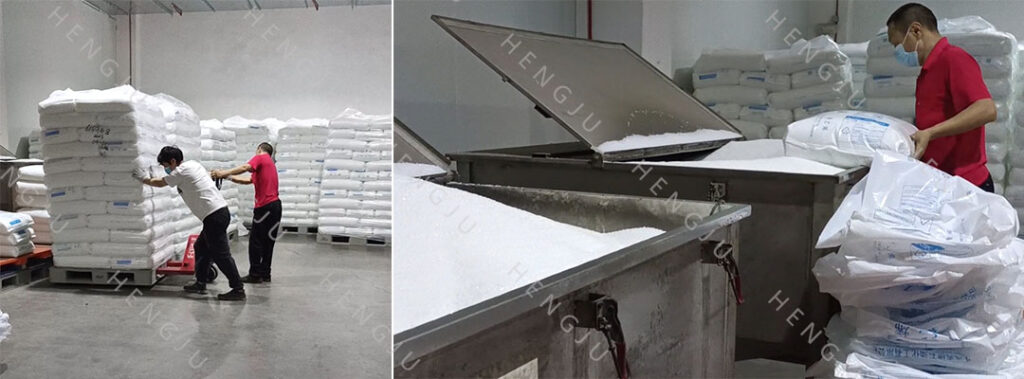With the rapid development of the manufacturing industry, the injection molding industry has higher and higher requirements for production efficiency and product quality. In order to meet market demand, the degree of automation in injection molding workshops has been continuously improved. However, despite the increasingly advanced production equipment, there are still many problems to be solved in the manual feeding link. Manual feeding is not only time-consuming and labor-intensive, but may also affect product quality due to inaccurate operation. How to reduce the cost and risk of manual feeding while ensuring production efficiency has become the focus of many companies.

Challenges and difficulties of manual feeding
Traditional injection molding workshops generally adopt manual feeding, but this method has many problems:
1.High work intensity and difficult to guarantee efficiency
Manual feeding requires workers to constantly carry raw materials, which is not only labor-intensive, but also prone to operational errors due to fatigue. Especially in a high-intensity production environment, it is difficult for workers to maintain a stable working state for a long time, which directly affects production efficiency.
2.Unstable material supply affects product quality
Manual feeding is difficult to accurately control the supply of materials, especially when multiple raw materials need to be mixed, manual operation is prone to errors. This error not only affects the consistency of the product, but may also lead to the production of batches of unqualified products, thereby increasing production costs.
3.Frequent production interruptions and high equipment maintenance costs
Due to the low efficiency of manual feeding, the production process needs to be frequently stopped for refilling. This not only reduces the utilization rate of the equipment, but may also cause additional wear and tear on the equipment due to frequent start and stop, increasing maintenance costs.
4.Prominent safety hazards and worrying health of workers
Long-term heavy lifting and high-temperature working environment make workers prone to safety accidents during the feeding process. Even a small accident may cause workers to be unable to continue working, thus affecting the normal operation of the production line.
Faced with these challenges, companies urgently need a more efficient and safe feeding method to replace traditional manual feeding. The intelligent central feeding system came into being. Its appearance not only brought revolutionary changes to the production of injection molding workshops, but also saved a lot of operating costs for companies.
Intelligent central feeding system: dual guarantee of efficiency and safety
With its automated and intelligent characteristics, the intelligent central feeding system has become an ideal choice for solving the feeding problem of injection molding workshops. The following are many advantages that the system brings to enterprises:

1.Automated operation, liberating human resources
The intelligent central feeding system completely replaces the tedious operation of manual feeding through automated control. Workers no longer need to carry out high-intensity material handling work, and can devote their energy to more technical operations, improving overall production efficiency. At the same time, the automated operation of the system eliminates the possibility of human error and ensures the stability of the production process.
2.Accurate feeding, improving product quality
The system’s built-in intelligent control module can accurately adjust the supply of each raw material according to production needs. Whether it is the supply of a single material or the mixing of multiple materials, the system can achieve precise control to ensure the consistency of each batch of products. This precise feeding not only reduces the waste of raw materials, but also effectively improves the qualified rate of products.
3.Reduce downtime and increase equipment life
The large-capacity storage bin of the intelligent central feeding system can stably supply materials for a long time, reducing the number of production downtimes caused by frequent feeding. By optimizing the production process, enterprises can not only improve the utilization rate of equipment, but also effectively extend the service life of equipment and reduce maintenance costs.
4.Improve safety and protect workers’ health
The automated feeding system greatly reduces the working time of workers in high temperature and high intensity environments, and reduces the incidence of work-related accidents. Enterprises no longer need to worry about production interruptions caused by workers’ health problems, and the overall safety of the workshop has been significantly improved.
Real case: the actual application effect of the intelligent central feeding system
After introducing the intelligent central feeding system, a company focusing on high-end plastic products has increased the overall production efficiency of the workshop by 35%. The system not only solves the problem of low efficiency of manual feeding, but also greatly improves the qualified rate of products by accurately controlling the supply of raw materials. It is worth mentioning that due to the reduction of frequent start and stop of equipment, the maintenance cost of equipment has also dropped by 25%. More importantly, the labor intensity of workers has been greatly reduced, and the safety record of the workshop has been greatly improved.
Looking to the future: the broad prospects of intelligent feeding system
With the continuous deepening of intelligent manufacturing, the automation level of injection molding workshops will continue to improve. As an important part of it, the intelligent central feeding system can not only effectively solve many problems of traditional manual feeding, but also bring considerable economic and social benefits to enterprises. In future production, this system will play an increasingly important role, helping enterprises to remain invincible in the fierce market competition.
With the introduction of the intelligent central feeding system, you will no longer be troubled by the dilemma of manual feeding. Through this intelligent solution, enterprises can not only improve production efficiency and reduce operating costs, but also create a safer and healthier working environment for employees. This is not only an upgrade of the production method, but also an important step for enterprises to move towards intelligent manufacturing.


